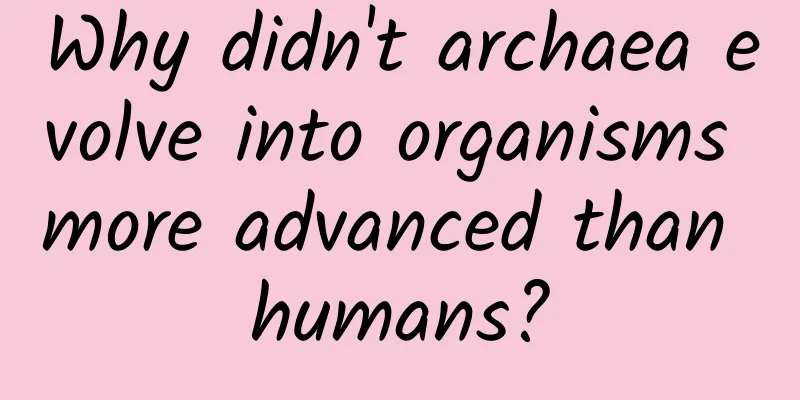Why didn't archaea evolve into organisms more advanced than humans?

|
In most people's eyes, bacteria are bad things because they can infect people and make them sick. Some people ask, if they are bad things, why have they evolved from ancient times to the present day and have not been extinct? In fact, our understanding of bacteria has entered a misunderstanding. Why? Because we understand bacteria too simply, for example, as a kind of organism or a collection of several organisms. However, the fact is that there are countless types of bacteria in nature. For example, we humans only have one kind. Counting tigers, lions, elephants, cows, sheep, pigs, mice, etc., there are only about 5,000 mammals in the world. If you expand it further, all animals in the world, from birds in the sky to earthworms on the ground and fish in the water, add up to more than 1 million species. What about microorganisms? They have hundreds of billions or even more. It can be said that this is an extremely huge and terrifying world, and their distribution is naturally everywhere. Some people ask, since bacteria are everywhere and archaea appeared more than a billion years earlier than humans, why didn’t they evolve into organisms more advanced than humans? Let’s talk about this question today. 01. Why didn’t archaea evolve into advanced organisms? In fact, it is quite the opposite. If archaea have the possibility of evolving into higher organisms, then they will be excluded from archaea and become one of the major forces in the field of eukaryotes. We often ask similar questions, such as did we evolve from monkeys? Actually, the answer to this question is no. We did not evolve from monkeys. On the contrary, the correct statement is that we and monkeys came from the same ancestor and then evolved separately. 02. Bacteria, Archaea, and Eukaryota Archaea have many unique characteristics of their own, as well as many characteristics that are between bacteria and eukaryotic cells. I will only talk about the nucleus. I made a simple evolution diagram. Bacteria, archaea, and eukaryotes are the three most basic types, all of which came from a common ancestor, a primitive single-celled organism. Then they began to evolve. The first node: the formation of the cell nucleus is a core differentiation point If the cell nucleus of this organism is formed, then it moves towards the higher stage of eukaryotes. If it does not form a cell nucleus, then it is a prokaryote. What is the function of the cell nucleus? To make an inappropriate analogy, the cell is a restaurant and the cell nucleus is a kitchen. The characteristic of prokaryotic cells is that they are simple barbecue stalls, with the kitchen and dining table placed together, so customers are easily affected by the smoke; while eukaryotic cells have independent kitchens, so that no matter what the kitchen looks like, diners are in a relatively clean and tidy restaurant. In other words, if one day a prokaryotic cell suddenly decides to upgrade its equipment and build a restaurant, then it jumps out of the prokaryotic field and becomes a eukaryotic organism, and its subsequent achievements belong to our eukaryotic army. The second node: The environment is the core. Some creatures live in a rich environment, so they are instantly satisfied, well-fed and well-dressed, and have a lot of things in their lives. They are in the air, in the ocean, on the surface of the human body, in the intestines, anyway, their traces are everywhere. Some creatures, however, have a bad reincarnation, and live in places like volcanic craters, high-salt areas, high-acid and high-alkali areas, etc. In those places, it is really a victory to survive. This group of archaea will naturally not be able to evolve into higher-level organisms. In fact, for archaea whose only purpose is survival, the single-cell form is more conducive to survival. At least you don't have to worry about heart, liver, lung, kidney deficiency, etc., you are a single cell, you can eat enough, and your family will not be hungry. In other words, if the living environment of archaea improves, then its evolution will naturally accelerate and develop in the direction of eukaryotes, and then develop into multicellular organisms and finally higher animals. 03. The difference between archaea and true bacteria (encyclopedia) 1. Morphologically, Archaea have cells with flattened rectangular geometric shapes, which are never seen in true bacteria. (It’s hard, a round spherical shape is the best) 2. In terms of intermediate metabolism, archaea have unique coenzymes. For example, methanogens contain F420, F430, COM and B factor. (What do they eat?) 3. Whether there are introns: Many archaea have introns. 4. In terms of membrane structure and composition, archaeal membranes contain ethers rather than esters, in which glycerol is connected to the long-chain hydrocarbon isoprene by an ether bond, rather than being connected to fatty acids by an ester bond. (There is not even an ester, a double-layer, incompatible) 5. In terms of respiration type, strict anaerobicity is the main respiration type of archaea. (The production of oxygen by cyanobacteria is one of the greatest advances in life.) 6. In terms of metabolic diversity, archaea are simple and not as diverse as true bacteria. (Diversity is king) 7. Archaea have more variation in molecular plasticity than true bacteria. 8. In terms of evolution rate, archaea are slower than true bacteria and retain more primitive characteristics. (Slow evolution, so aggrieved) 04. Woese Theory Here I would like to add the Woese theory, which was proposed by Woese in 1977 after extensive comparison of bacterial 16S rRNA base sequences. He believed that the development of the biological world was not a process from simple prokaryotes to more complete and complex eukaryotes, but that there were three distinct gene systems, namely archaea, bacteria and eukaryotes. He also believed that these three gene systems developed almost simultaneously from a certain starting point, which was a primitive ancestor that is still unclear. The diagram is as follows: I thought of another question. We humans come from a common ancestor, an African woman (African origin theory). Then, some people did not evolve in the end and became wild tribes, or returned to the ape tribe. That is bacteria. Some people were unfortunate enough to live in Africa, and so they still lived in tribes many years later. They were archaea. Others were smart and left Africa, and then formed people in Asia, Europe and America. These people entered the civilized era and reached the peak of life. They were eukaryotes. |
<<: Is plant-based meat healthier than animal-based meat?
Recommend
Analysis of Dianping's Membership Operation System
Because I got a high-quality free meal on Dianpin...
With all the dividends lost, how to use competitors to increase user growth?
Now many products are facing the dilemma of sever...
Marketing Artificial Intelligence Institute: AI for Retail Leaders
Artificial intelligence continues to transform ev...
ExoPlayer supports multiple media formats and streaming protocols
ExoPlayer Introduction ExoPlayer is an open sourc...
Apple launches App Store gift cards. Can it learn from Tencent to open up China’s paid market?
In China, gift cards from various merchants are v...
Android phones have exceeded 20G of RAM! How much RAM is enough?
How much running memory is enough? Today, the edi...
Although it is a fight between the same school, it is also a bloody battle. Galaxy E8 and Zeekr 007, which one do you choose?
As we all know, the development speed of the dome...
4 steps to solve the advertising problem, analysis of advertising strategies in the wedding photography industry!
Target: A national wedding photography chain clie...
What kind of silent wars did Alibaba and JD.com fight to compete for Double Eleven traffic?
With only a few days left until Double Eleven , m...
Mobile QQ 8.1.8 is officially launched: no more worry about losing chat records
Recently, Tencent officially announced that mobil...
How to quickly gain 100,000 followers on Zhihu with these 5 points!
To be honest, the president was quite reluctant t...
National Malaria Day | How much do you know about infectious diseases that claim the lives of millions of people every year?
April 26, 2024 is the 17th "National Malaria...
iQIYI's Duan Youqiao: Living room and bedroom are the most important markets for VR
In the Chinese Internet circle, where the term &q...
Technology Morning News | Shanghai adds 3 medium-risk areas
【Today’s cover】 Golden rays of light pierce throu...
Sony: Semiconductor business investment to decrease by 30% year-on-year in the next three years
Sony Group's semiconductor division recently ...









